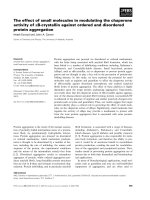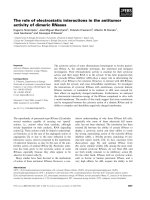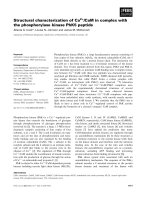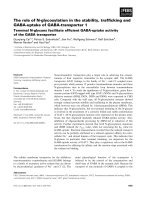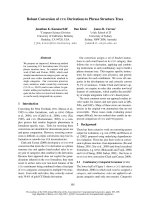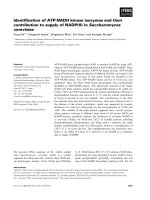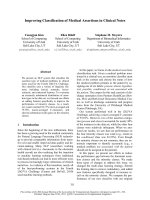Báo cáo khoa học: "Radiographic diagnosis of diaphragmatic hernia: review of 60 cases in dogs and cats" pdf
Bạn đang xem bản rút gọn của tài liệu. Xem và tải ngay bản đầy đủ của tài liệu tại đây (1.07 MB, 6 trang )
-2851$/ 2)
9H W H U L Q D U \
6FLHQFH
J. Vet. Sci.
(2004),
/
5
(2), 157–162
Radiographic diagnosis of diaphragmatic hernia: review of 60 cases in dogs
and cats
Changbaig Hyun
Companion Animal Science, School of Veterinary Sciences, The University of Queensland, St Lucia, QLD 4072, Australia
Sixty cases of diaphragmatic hernia in dogs and cats were
radiologically reviewed and categorized by their characteristic
radiographic signs. Any particular predilection for age, sex,
or breed was not observed. Liver, stomach and small
intestine were more commonly herniated. At least two
radiographs, at different angles, were required for a valid
diagnosis, because some radiographic signs were not visible
in a single radiographic view and more clearly detectable in
two radiographic views. In addition to previously reported
radiographic signs for diaphragmatic hernia, we found that
the location of the stomach axis and the displacement of
tracheal and bronchial segments were also useful
radiographic signs.
Key words:
diaphragmatic hernia, radiography, traumatic, x-
ray, diagnosis
Introduction
Diaphragmatic hernia is a protrusion of abdominal viscera
through an opening in the diaphragm and is caused mainly
by trauma such as an automobile accident and rarely by
congenital defects. Radiographic diagnosis is the single
most important diagnostic method of detecting
diaphragmatic hernia in dogs and cats, although it is not
always easy to identify diagnostic radiographic signs,
especially in cases with pleural effusion. Therefore, a
radiographic diagnosis should be accompanied by other
diagnostic measures such as contrast studies and
ultrasonography [1,4,5,8,9,10]. Loss of diaphragmatic line
and cardiac shadow, abdominal gas shadow in thorax, and
wasp-shaped abdomen are characteristic radiographic signs
[2,3,4,6,7,11,12,14,15].
In this study, 60 clinical cases of diaphragmatic hernia
were radiologically examined and categorized by their
radiographic features. Additionally, several new radiographic
signs have been included in our radiographic observation list
for diaphragmatic hernia.
Materials and Methods
Sixty cases of diaphragmatic hernias from 1975 to 1997 at
the Small Animal Teaching Hospital, the University of
Queensland, were radiologically examined. Congenital
diaphragmatic hernias (true diaphragmatic hernias) were not
included in this study. Details of affected animals, main
herniated organs and location of herniation were recorded.
Characteristic radiographic signs were categorized by the
following observation points:
i) Diaphragm: diaphragmaticolumbar recess, diaphragmatic
line, divergence of the diaphragmatic crura, contrast
between the diaphragm and liver
ii) Thorax: intrathoracic density, pleural effusion, mediastinal
shift, pneumothorax, tracheal displacement
iii) Heart: cardiac displacement, cardiac shadow, cardiophrenic
angle
iv) Lung: displacement of bronchial segment, lung
shadow, pulmonary vascular marking, pulmonary vascular
condition
v) Abdomen: Abdominal gas shadow, wasp-shape of
abdomen, loss of abdominal organ shadow, cranial
displacement of abdominal organ, loss of falciform
ligament, stomach axis
vi) Miscellaneous: traumatic signs
Results
Animals
Forty-two cases were dogs (24 males, 17 females and 1
undetermined) and 18 were cats (9 males, 5 females and 4
undetermined). The age of affected animals varied from 7
weeks to 10 years (mean: 2.64 years old, dog: 2.63 years,
cat: 2.66 years). The mean age of affected male animals was
3.71 years old (dog: 3.51 years, cat: 3.22 years), while that
of female animals was 1.44 years old (dog: 1.49 years, cat:
1.44 years). Any particular predilection for either age, sex,
breed or species was not observed.
*Corresponding author
Phone: 61-2-9295-8522; Fax: 61-2-9295-8501
E-mail:
158 Changbaig Hyun
The site of herniation and the herniated organs
Right side diaphragmatic hernias were more common,
although a noticeable difference in the site of herniation was
not observed (Table 1). The site of herniation could not be
determined in 3 cases, because either only one radiographic
view was available or severe pleural fluid accumulation was
present. In 41 cases (68%), more than one organ was
herniated (Table 1). Liver was the predominant herniated
organ (85%), especially in right side hernias (96% but 65%
in left side) whereas stomach was the prominent organ in the
left side hernias (95% but 17% in right side; Table 1).
Regardless of the site of herniation, hernias involving the
small intestine was more evenly distributed (42% in the right
side and 50% of the left side; Table 1).
Radiographic signs related to diaphragm
Decreased diaphragmaticolumbar recess (angle) was
observed in 40% of the cases and more obvious in left side
diaphragmatic hernias (60%) than any other side hernias
(Table 2). Due to fluid accumulation, we were unable to
determine the diaphragmaticolumbar recess in one of the
cases. Loss of the diaphragmatic line was obvious in all
cases, although it varied by radiographic views (Table 2). In
some cases, partial loss of the diaphragmatic line was seen
in lateral view but completely obliterated in the dorsoventral
(D-V) view and vice versa. The diaphragmatic crura was
diverged in 25% of the cases (Table 2) and was
undetermined in some cases with pleural effusion. A loss of
contrast between diaphragm and liver was also observed in
all cases.
Radiographic signs in thorax
Increased intrathoracic density was the most common
intrathoracic sign (87%) seen on the radiograph, although
this density could be decreased due to the herniated stomach
gas shadow (8%; Table 3). Pleural effusion was
predominantly found in the both and central side hernias
(both side: 10/10, central side: 3/3; Table 3). In 58% of the
cases, a distinct mediastinal shift was observed (35/60; Table
3), usually located at the opposite side of herniation. In 9
cases, this mediastinal shift was unable to determine due to a
lack of D-V view (3 cases), poor positioning (1 case), fluid
accumulation (2 cases) and severe abdominal organ prolapse
Table 1.
The composition of the herniated site and organs in
diaphragmatic hernia
Right Left Both Central
Un-
certain
Total
L1011113
L,St 2316
L, St, SI 1 7 1 9
L, St, SP 1 1 2
L,St, Sp, SI 2 2
L, St, SI, LI 3 3
L, St, Sp, SI, LI 1 1
L, SI 814 13
L, SI, LI 1 1
L, LI 1 1
St 5 5
St, SI 1 1
St, Sp, SI 1 1
SI 1 1
SI, Sp 1 1
Total 2420103 360
L: liver, St: stomach, SI: small intestine, LI: large intestine, Sp: spleen
Table 2.
Radiographic abnormalities in diaphragm
Signs Presence Type Frequency
Decreased
diaphragmati-
columbar recess
Present
Right 6
Left 12
Both 5
Absent
Right 20
Left 8
Both 5
Uncertain 1
Loss of
diaphragmatic line
Present
Partial 40
Complete 20
Absent Absent 0
Divergence of
diaphragmatic
crura
Present 15
Absent 44
Uncertain 1
Table 3.
Radiographic changes in thorax
Signs Alteration Frequency
Intrathoracic
density
No change 3
Increased 52
Decreased 5
Pleural effusion
No change 39
Right 2
Left 6
Both/central 12
Uncertain 1
Tracheal
displacement
Normal 11
Dorsal 46
Cranial 2
Ve n t r a l 1
Mediastinal shift
No change 16
Right 18
Left 17
Uncertain 9
Radiographic diagnosis of diaphragmatic hernia: review of 60 cases in dogs and cats 159
(3 cases). Two cases of rib fractures were also observed,
where one had radiographic signs of pneumothorax. In 82%
of the cases, the trachea was abnormally displaced (mostly
dorsal displacement; Table 3).
Radiographic signs related to heart
The heart was displaced in 70% of the cases, where the
direction of displacement varied (Table 4). However, this
displacement could not be determined in 4 cases owing to
fluid accumulation and severe herniation of abdominal
organs. Cardiac shadow and cardiophrenic angles were
partially or completely obliterated in all cases except 2
undetermined cases (Table 4).
Radiographic signs related to lung
In 82% of the cases, lung shadows were either partially (6/
49) or completely (43/49; Table 6) obliterated ventrally in
the lateral view, but more obvious in the same side of
herniation in the D-V view. In many of the cases, pulmonary
vascular markings were not clearly visible and the lungs
were compressed (Table 6). Bronchial segments were
displaced in 48% of the cases, especially in the middle
bronchus (23/29; Table 6). However, it was not examinable
in 30% of the cases due to the invasion of the stomach into
the thoracic cavity.
Radiographic signs related to abdomen and
miscellaneous radiographic signs
In 73% of the cases, abdominal gas shadows originating
from small intestines or stomach were observed in the
thoracic cavity (Table 6). The abdominal organs were
displaced cranially in 97% of the cases and variably
disappeared from the abdomen, depending on the severity of
the herniation (Table 6). In 68% of the cases, the falciform
ligament was not visible and a wasp-shaped abdomen,
which is a particular sign of diaphragmatic hernia, was
observed in 52% of the cases with diaphragmatic hernias
(Table 6). The stomach axis was abnormally displaced in
67% of the cases (more commonly craniocaudal direction;
Table 6). Additionally, traumatic signs such as rib fractures
were also detected in 16.7% of the cases examined.
Discussion
In this study, 60 clinical cases with diaphragmatic hernia
documented over a period of 22 years were radiologically
reviewed. Although it was more common in younger and
female animals, we could not conclude there was any
particular predilection for age and sex, because only a small
number of cases were used in this study.
In previous studies, the left sided hernia was believed to be
Table 4.
Radiographic abnormalities in heart
Signs Presence Type Frequency
Cardiac
displacement
Present
Left 15
Right 17
Dorsal 9
Cranial 1
Absent 14
Uncertain 4
Loss of cardiac
shadow
Present
Partial 39
Complete 19
Absent 0
Uncertain 2
Obliterated
cardiophrenic
angle
Present
One 15
Both 33
Absent 0
Uncertain 12
Table 5.
Radiographic abnormalities in lung
Signs Presence Type Frequency
Displacement
of bronchial
segment
Present
CR 3
MID 18
CA 2
UP 1
CR+MID 5
Absent 13
Uncertain 18
Loss of lung
shadow
Present
Left
Partial: 1
Complete: 19
Right
Partial: 3
Complete: 18
Both
Partial: 2
Complete: 6
Absent 8
Uncertain 3
Loss of
pulmonary
vascular
marking
Present
Left 21
Right 22
Both 6
Ve n t ral 5
Absent 6
Lung
condition
Compressed
Left 20
Right 23
Both 7
Uncertain 3
Uncertain 1
Invisible 5
CR: Cranial, MID: Middle, CA:Caudal, UP:upright, CR+MID: Cranial
and middle.
160 Changbaig Hyun
more common, since the right sided location of the liver
could serve as a barrier for the herniation of abdominal
organs into the thorax [12]. However, this predilection was
not observed in this study, which is consistent with previous
reports [3,5,13,14].
The type of herniated organs is more related to the
anatomical proximity of the organ to the rupture site. Thus
liver, stomach and small intestine were more commonly
found in thorax [11,14]. Since the stomach is anatomically
closer to the left side of the diaphragmatic crura than the
liver which is closer to the right side crura, the stomach was
found to be more prominent in left side hernias whereas the
liver in right side hernias [4,5]. Similar findings have found
previously [4,5].
Consistent with previous reports [4,7,12], the
diaphragmaticolumbar recess was moved further caudally
than normal, the angle between the lumbar spine and
diaphragm was decreased and the separation of the crura
was also increased. Loss of the diaphragmatic outline, a
classic radiographic sign of diaphragmatic hernia, was
found to be vary from partial to complete loss depending on
the severity of the rupture and number of radiographs taken
at different angles [11]. This loss of the diaphragmatic
outline was also more easily detected in the lateral view than
the D-V view. Divergence of the diaphragmatic crura should
also be considered to be a radiographic sign of
diaphragmatic hernia [7]. However, it was undetectable in
many of the cases, especially if the intrathoracic density was
increased due to loss of the contrast between diaphragm and
liver by pleural effusion and prolapse of abdominal organs.
Pleural effusion and herniated organs may not only be the
major causes of the increased intrathoracic density but also
be the major inhibitor of radiographic interpretation [11,14].
Kealy [7] found a close relationship between hepatic
prolapse and body fluid effusion in diaphragmatic hernia.
The impairment of venous return by a herniated liver can be
resulted from pleural effusion suggests that pleural effusion
would be more common in right side hernias. However, we
found that pleural effusion was more common in left side
hernias suggesting that the presence of ascites is more
closely related to pleural effusion than the hepatic prolapse
[14]. In this study, pleural effusion was observed in all both
side hernias indicating that the severity of rupture was
related to the presence of pleural effusion. The pleural
effusion appeared to be nonhomogeneous, possibly due to
the fat from falciform ligament or omentum, in contrast to
homogeneous appearances observed in cases with
pulmonary neoplasm and heart diseases [4,12]. Mediastinal
shift is an another common finding in diaphragmatic hernias
[2,7,12]. The mediastinum in affected animals shifted to
either the right or the left side in the lateral view and dorsally
in the D-V view. In previous studies, tracheal displacement
was overlooked as an indicator of diaphragmatic hernias.
Table 6.
Radiographic abnormalities in abdomen
Signs Presence/Type Frequency
Loss of falciform
ligament
Present 41
Absent 19
Abdominal gas
shadow
Present 44
Absent 16
Wasp shape
Present 31
Absent 29
Loss of abdominal
organ
Present 60
Absent 0
Cranial
displasment
Present 58
Absent 2
Stomach axis
Normal 22
Craniocaudal 27
Dosorcranial 7
Ve n t r a l 2
Perpendicular 1
Invisible 1
F
ig. 1.
Radiographic diagnosis of diaphragmatic hern
ia
(
dorsoventral view), Airedale terrier dog, male, 4 years old.
T
he
d
iaphragmatic line is obliterated due to the increas
ed
i
ntrathoracic density. The lung is collapsed (arrow) and
its
s
hadow is obliterated by the cranial displacement of abdomin
al
o
rgans. Due to pneumothorax, the right-side cardiac shadow
is
m
ore clearly visible. The characteristic abdominal gas shadow
is
a
lso observed in the thoracic cavity.
Radiographic diagnosis of diaphragmatic hernia: review of 60 cases in dogs and cats 161
Although several diseases can cause tracheal displacement,
it was a very consistent and reliable indicator of
diaphragmatic hernia in this study. Dorsal displacement was
prominent in our findings suggesting that the herniated
abdominal organs might have pushed the trachea upward.
High incidences of pneumothorax, pneumomediastinum
and intrathoracic and intrapulmonary hemorrhage have
previously been reported in diaphragmatic hernias [7]. Since
more than 90% of the cases resulted from automobile
accidents, higher incidence rate of pneumothorax was
expected in this study. However, only two cases were
involved with pneumothorax.
Radiographic changes related to cardiac shadow and
location, and the angle between heart and diaphragm are
also important radiographic points for distinguishing
diaphragmatic hernia, although it will be invisible in cases
with either pleural effusion or a heavy prolapse of
abdominal organs [2,11,12]. In this study, the degree and
direction of the cardiac displacement varied with the rupture
site and the amount of abdominal viscera within the pleural
space. Also, cardiac displacements generally were in the
opposite direction to the ruptured site in the D-V view and
dorsally in the lateral view. This displacement was more
easily detectable on two different views of radiography.
Cardiac shadow was obliterated either partially or
completely in most cases, depending on the severity of
effusion and prolapse. Regardless of radiographic angles, it
was easily detected (Lateral: 89%, D-V: 90%) as reported by
Sullivan and Lee [11]. Cardiophrenic angles, the angles
between the heart and diaphragm, can be obliterated or
reduced in detail, in diaphragmatic hernias with pleural
effusion and a heavy prolapse of abdominal organs. In this
study, either side of angles were either partially or
completely obliterated in 80% of the cases, however, more
commonly both angles were obliterated.
Because of cranial displacement of abdominal organs and
pleural effusion, lung lobes can be compressed or collapsed
in diaphragmatic hernia and thus the clarity of normal
pulmonary vascular markings and lung shadow can be
affected on the radiograph [7,11,12]. In this study, lung
compressions were observed in 88% of the cases, mainly in
the lung lobes closely located to the rupture site, although it
occurred less (27%) in previous reports [11]. This difference
may be due to wider range of the radiographic scope
employed in this study. Radiographic changes in lung
shadow and pulmonary vascular markings are not direct
signs of diaphragmatic hernia, and furthermore many other
pulmonary diseases can cause similar radiographic changes
[7,11,12]. A displacement of the pulmonary bronchi has
never been reported previously, however, we found that in
more than 50% of the cases, the pulmonary bronchi were
interrupted in their pattern, and either displaced or curved
dorsally towards the lung in cases with heavy prolapse in
hilus, or caudodorsally if less compressed, as the result of
the compression of the pulmonary segments by herniated
organs. The displacement of the middle bronchus was more
obvious in many cases due to its anatomical proximity to
herniated organs.
Presence of abdominal gas shadows in thorax is the most
reliable radiographic sign indicating diaphragmatic hernia
[2-4,6,11-14]. The cranial displacement of abdominal
organs results in the abdominal gas shadow in thoracic
cavity and an empty and wasp-shaped abdomen [4,7,12,14].
In this study, abdominal gas shadows and wasp-shaped
abdomen were observed in 73% and 52% of the cases,
respectively.
The falciform ligament is located between the ventral
border of the liver and ventral abdominal wall. If this
falciform ligament is herniated into the thoracic cavity, the
ventral border of the liver will displace toward the
abdominal wall and the shadow of falciform ligament will
be obliterated from the abdomen [4]. Therefore, this can be a
good radiographic sign of diaphragmatic hernia. Although
locating the falciform ligament is challenging in dogs, we
found the falciform ligament was disappeared from the
abdomen in 68% of the cases.
In diaphragmatic hernias, the stomach can be displaced
cranially and also its axis can be directed cranioventrally,
instead of caudoventrally if the liver is involved in the
hernia. Therefore, the displacement of the stomach should
be included in the radiographic signs of the diaphragmatic
hernia [4]. In more than 50% of the case, this axis was
F
ig. 2.
Radiographic diagnosis of diaphragmatic hernia (later
al
v
iew), Kelpie dog, male, 18 months old.
The diaphragmatic li
ne
i
s partially obliterated (white arrow) due to the cran
ial
d
isplacement of abdominal organs. The increased intrathorac
ic
d
ensity and abdominal gas shadow are observed in the thorac
ic
c
avity (arrow head). The cardiac shadow is complete
ly
o
bliterated due to the pleural effusion and the invasion of t
he
a
bdominal organs. The lung is collapsed (open arrow) and t
he
t
rachea is displaced dorsally. Due to the cranial displacement
of
t
he abdominal organs, the characteristic empty and wasp-shap
ed
a
bdomen is also clearly observed on this radiograph.
162 Changbaig Hyun
displaced cranioventrally.
Because automobile accidents are the predominant cause
of diaphragmatic hernias, traumatic signs such as rib
fractures should not be overlooked [11,13]. However, it was
observed only in 16% of the cases, although the automobile
accident was the major cause of diaphragmatic hernia in this
study.
In summary, 60 cases of diaphragmatic hernia were
radiologically reviewed and categorized by radiographic
features. The type of herniated organ was more closely
related to the anatomical proximity of the organ to the
ruptured site. Many characteristic radiographic signs were
not identifiable in case of pleural effusion or heavy prolapse
of abdominal organ. More than two radiographs taken at
different angles (e.g. lateral and D-V views) were essential
for valid diagnosis. In addition to previously documented
radiographic signs, we found displacement of tracheal and
bronchial segments and the location of the stomach axis to
be good radiographic indicators of diaphragmatic hernia.
Acknowledgment
I am gratefully appreciated Dr. Lopeti Lavulo for advice
on the manuscript preparation.
References
1.
Allan GS.
Cholecystography: An aid in the diagnosis of
diaphragmatic hernias in the dog and cat. Aus Vet Pract 1973,
3
, 7-8.
2. Burk RL, Ackerman N. Small Animal Radiology, pp. 33-
38, Churchill Living stone, London, 1986.
3. Carb A. Diaphragmatic hernia in the dog and cat. Vet Clin
North Am Small Anim 1975, 5, 477-494.
4. Fagin B. Using radiography to diagnose traumatic
diaphragmatic hernia. Vet Med 1989, 89, 663-672.
5. Garson HL, Dodman NH, Baker GJ. Diaphragmatic
hernia: Analysis of fifty-six cases in dogs and cats. J Small
Anim Pract 1980, 21, 469-481
6. Herrtage ME, Dennis R. The thorax. In: Lee R (ed.).
Manual of Radiology in Small Animal Practice, pp. 89,
British Small Animal Veterinary Association, London, 1989.
7. Kealy KJ. Diagnostic Radiology of the Dog and Cat, pp.
225-227, Saunders, Philadelphia, 1987.
8. Koper S, Mucha M, Silmanowicz P, Karpülski J, Zilo T.
Selective abdominal angiography as a diagnostic method for
diaphragmatic hernia in the dog: An experimental study. Vet
Radiol 1982, 23, 50-55.
9. Rendano VT. Positive contrast peritoneography: An aid in
the radiographic diagnosis of diaphragmatic hernia. Vet
Radiol 1979, 20, 67-73.
10. Stickle RL. Positive-contrast ceilography (peritoneography)
for the diagnosis of diaphragmatic hernia in dogs and cats. J
Am Vet Med Assoc 1984, 185, 295-298.
11. Sullivan M, Lee R. Radiological features of 80 cases of
diaphragmatic rupture. J Small Anim Pract 1989, 30, 561-
566.
12. Suter PF. Abnormalities of the diaphragm. In: Suter PF, Lord
PF (eds.). A Text Atlas of Thoracic Diseases of the Dog and
Cat, pp. 179-204, Wettswill, Switzerland, 1984.
13. Walker RG, Hall LW. Rupture of the diaphragm: Report of
32 cases in dogs and cats. Vet Rec 1965, 77, 830-837.
14. Wilson GP, Newton CD, Burt JK. A review of 116
diaphragmatic hernias in dogs and cats. J Am Vet Med Assoc
1971, 159, 1142-1145.



